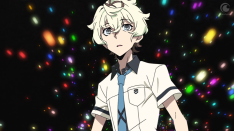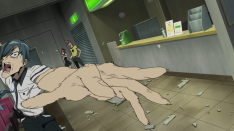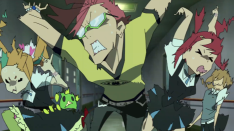Kiznaiver was probably the most controversial show of the Spring 2016 season, and for some pretty obvious reasons. Not only is it the product of the divisive studio Trigger, but it’s also a teenage melodrama written by Mari Okada. If there weren’t a few angry and/or thoughtful think pieces written for this show, I’d be very surprised. However, in the months leading up to its airing, no one seemed to notice these red flags; and now that everyone has shouted and made stupid hot takes about Mari Okada’s personal life (which we know nothing about, by the way), I’m here to sit in the dust and write my own unoriginal thinkpiece about how Kiznaiver is kind of a mess.
To clarify though, I’d like to first point out the major positive of Kiznaiver: It is absolutely gorgeous! Studio Trigger have always been a little shaky when it comes to TV productions, but for the first time ever they’ve really been able to showcase their talent for animation on a week to week basis. The character designs are varied, unique, and they move beautifully in motion, in spite of their heavy amounts of detail. In fact, each design gets multiple moments to shine, contorting and expressing their personality in amazing cuts of character animation. And this is just in terms of pure fluidity, because when it comes to shot composition and direction, Kiznaiver is even more jaw dropping. Every episode is filled to the brim with stunning cinematography, to the point where my screenshots folder is now filled with hundreds of amazing moments. This is only Hiroshi Kobayashi’s TV directorial debut, but I’m already anticipating his next major project. He has some amazing talent that should not be overlooked.
Beyond the aesthetic brilliance of the show, another seemingly positive point should be the writer Mari Okada. Now I know a lot of people have complicated feelings on Miss Okada, but I think most people will agree with me when I say she has written at least a few good shows. Her works with director Tatsuyuki Nagai have a pretty big following, and many tout Toradora and Wandering Son as classics of the anime medium. She’s good at what she does, even if her melodramatic tendencies are easy to spot once you find them. So it pains me to say that the weakest part of Kiznaiver is easily the writing. Which is weird because the premise seems almost tailor made for her. Seven teenagers bonded together by their physical pain, getting to know each other, potentially falling in love – if that isn’t a Mari Okada project, then frankly I don’t know what is.
Sadly though, the devil really is in the details, and ultimately Kiznaiver’s flaws are found in what is written around the series’ central story concept. I mean, if you’re going to write a symbolic science-fantasy story your plot should probably be interesting, but wow, Kiznaiver’s actual plot is incredibly bland! I do not care one bit about the Kizuna System, or it’s backers, or the stupid nonsensical scientific experiments conducted by Sugamori City’s secret underground society. The only time when these elements of the story work is when their intertwined with the character’s struggles, but even then they can feel forced. It also doesn’t help that so much of this plot is delivered through blunt and lazy exposition scenes, where the teacher characters try and fail to make the Kizuna System make any sort of logical sense. Maybe these problems could have been fixed with extra time, but considering Kiznaiver’s twelve episode length, that likely wasn’t an available option.
And even though there are many positive moments in the character writing here, those good points can be ruined by some cringeworthy anime cliches. In the first episode alone we have a stupid panty shot gag, and then in the next a mean spirited fat joke. These little moments can often destroy the series’ overall tone, which is supposed to be emotionally charged, not cynical and otaku centric. Since you’re theme is about empathy, you really shouldn’t undermine it by forcing in these flat tropes.
That being said, focusing on these negatives entirely makes them seem a lot more annoying than they actually are, and I did mention that I do like the character writing. Not all of it mind you, but a good 75 percent of it is some prime stuff. Mari Okada has always had a knack for character interaction, and there are moments in the series where the cast’s conversations just blow it out of the park. From the entirety of episodes 6 and 7, to the intense climax of episode 9, there are times where everything just clicks. You can understand the characters, the visual execution is spot on, and you can feel the series at its peak powers.
One of my favorite moments in particular occurs in episode 10, when Katsuhira learns the truth behind his past. I won’t spoil the specifics here, but when he discovers it he explodes with emotion, crying at the top of his lungs. That may sound cheesy, but the voice acting, shot composition, and tone sell it. It’s almost enough to make you forget the clunky exposition beforehand, or the fact that Sonozaki’s situation doesn’t make any sense. You just feel the show’s earnest emotions.
Which really helps explain how, even though Kiznaiver is flawed as hell, I can’t bring myself to call it a bad show. Because I understood Maki’s struggle, in spite of her arc’s stupid heteronormative ending, and because I felt the group’s friendship and love for each other, despite the build up for Nico’s crush being nonexistent, I couldn’t just brush the show off as a complete failure of teenage melodrama. Like the cast, even if I didn’t understand the emotions everyone felt, I carried them with me like an invisible scar. And the fact that I could see the animator’s effort, and see how Trigger was willing to risk their studio on such an emotionally charged project, only made me root for the show more. I wanted to see it succeed, even as it struggled across the finish line.
In a better world, Mari Okada would have been given a more concrete plot outline, or maybe the opportunity to at least write a few more rough drafts. Maybe then the message of the show could have ended up being more than just a complex articulation someone saying, “Empathy is good,” taking the symbolism behind the cast’s visible and invisible scars and refining them into a more satisfactory ending thesis. But alas, we got the anime we got. However, even with that knowledge, I don’t think I can forget those moments that made me like the show in the first place.
Kiznaiver is a mess.
But it’s a good mess. It’s one that I can appreciate, and I hope I’ll remember it for years to come.

















For all the reviews on Kiznaiver that’ve popped up over the past few weeks (and boy are there a lot!), this one actually does a really good job of taking both its myriad positives and flaws into account without getting bitchy about them – and on a more personal note, it sums up my own thoughts on the show far better than I ever could. So kudos, and thanks for the great post!
[…] of you were reading my writing back in the Brave New Moe days, you’d know that I wrote a pretty long post defending the flawed show Kiznaiver. Hell, even if you only know me from this blog, you’d see […]